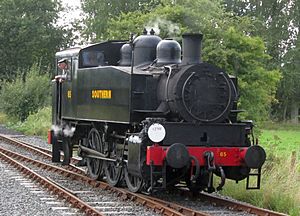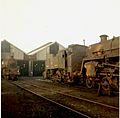USATC S100 Class facts for kids
Quick facts for kids USATC S100 class |
|
 |
|
| Former Southern Railway USA class No. 65 preserved at the Kent and East Sussex Railway | |
| Power type | Steam |
|---|---|
| Designer | Howard G. Hill |
| Builder | Davenport Locomotive Works (109), H. K. Porter, Inc (150), Vulcan Iron Works (123) |
| Build date | 1942–1944 |
| Total production | 382 |
| Configuration | 0-6-0T |
| UIC classification | C nt |
| Gauge | 4 ft 8 1⁄2 in (1,435 mm) standard gauge |
| Driver diameter | 4 ft 6 in (1,372 mm) |
| Minimum curve | 150 ft (45.72 m) radius |
| Length | 29 ft 6 in (8.99 m) |
| Width | 9 ft 0 in (2.74 m) |
| Height | 12 ft 1+5⁄8 in (3.70 m) |
| Locomotive weight | 100,650 lb (45,654 kilograms) |
| Fuel type | Coal or Oil |
| Fuel capacity | 2,500 lb (1,130 kilograms) coal, or 300 US gallons (1,100 L; 250 imp gal) oil |
| Water capacity | 1,200 US gallons (4,500 L; 1,000 imp gal) |
| Boiler pressure | 210 lbf/in2 (1.45 MPa) |
| Fire grate area | First 50: 19.4 sq ft (1.80 m2), Remainder: 18.3 sq ft (1.70 m2) |
| Heating surface: Tubes | 790 sq ft (73 m2) |
| Heating surface: Firebox | 86 sq ft (8.0 m2) |
| Heating surface: Total | 876 sq ft (81.4 m2) |
| Superheater type | None |
| Cylinders | Two, outside |
| Cylinder size | 16.5 in × 24 in (419 mm × 610 mm) |
| Valve gear | Outside Walschaerts |
| Valve type | 8-inch (203 mm) piston valves |
| Tractive effort | 21,630 lbf (96.2 kN) |
| Factor of adhesion | 4.65 |
The USATC S100 Class is a type of steam locomotive. It was designed by the United States Army Transportation Corps (USATC). These locomotives were built for shunting (moving trains around) during World War II. They worked in Europe and North Africa.
After the war, these locomotives were used in many countries. This included places like Austria, China, Egypt, France, Great Britain, Greece, Iran, Iraq, Israel, Italy, the Netherlands, Palestine, the United States, and Yugoslavia.
Contents
Wartime Development and Use
The S100 was a side tank design. This means it carried its water in tanks on its sides. Colonel Howard G. Hill designed this locomotive.
In 1942, the USATC ordered 382 S100 locomotives. They were built by three different companies:
- Davenport Locomotive Works in Iowa
- H. K. Porter, Inc in Pittsburgh
- Vulcan Iron Works in Wilkes-Barre
These locomotives were sent to Great Britain in 1943. They were kept there until 1944. After D-Day, which was a major event in World War II, they were shipped to Continental Europe.
Building the S100 Locomotives
Many S100 locomotives were built between 1942 and 1944. A total of 382 were made. The main builders were H. K. Porter, Vulcan Iron Works, and Davenport Locomotive Works. Each company built a certain number of these locomotives over these years. For example, H. K. Porter built 150, Vulcan Iron Works built 123, and Davenport Locomotive Works built 109.
Use After World War II
After the Second World War ended, many S100 locomotives were sold to different railway companies.
- The SNCF in France bought 77 S100s. They called them the class 030TU.
- Jugoslovenske železnice (Yugoslav State Railways) bought many S100s. They named them class 62. In the 1950s, Yugoslavia even built more of these locomotives. This brought their total number of class 62 engines to 129.
- The Hellenic State Railways in Greece got 20 S100s. They called them class Δα.
- Österreichische Bundesbahnen in Austria bought 10. They became class 989.
- Ferrovie dello Stato in Italy got four. They were called class 831.
Some S100s were also sold for industrial use in the United States. Companies like Georgia Power and Oklahoma Gas & Electric used them.
In the Netherlands, a coal mining company called Oranje-Nassau Mijnen bought two S100s. One of these, ON-26, is now preserved at a museum railway.
The Southern Railway (UK) bought 15 S100s. They used 14 for work and one for spare parts. They called them the USA Class. Other S100s were used by British industries. This included the National Coal Board and the Austin Motor Company.
China received about 20 S100s. They named them class XK2. In 1946, Egyptian State Railways bought eight. The UK War Department loaned six to Palestine Railways. Two of these later became part of Israel Railways.
Iraqi State Railways bought five S100s. They were called Class SA. At least two of these were still working in 1967.
Postwar Design Influence
The S100 locomotives also inspired new designs in Europe.
- Yugoslavia's JŽ added to their class 62 by ordering more similar engines. These new engines had small differences, like a different type of frame.
- The British Great Western Railway (GWR) used many S100s during World War II. The GWR 1500 Class was partly inspired by the S100. It used similar features like outside cylinders and a short wheelbase.
Continuing Commercial Use
A few former JŽ 62 locomotives are still working today. This is more than 65 years after they were built! At least two of them work as switcher locomotives (shunters) at a steel plant in Zenica, Bosnia-Hercegovina.
Survival and Preservation
More than 100 S100 locomotives still exist today. Some are preserved in museums, while others are stored or need repair. Most are in Europe or North America. There are also two in China and one in Egypt. You can find an online list of them through 'Project 62'.
One S100, number 5002, is being restored by private owners in Baraboo, Wisconsin. This locomotive was once used at Naval Yards in Philadelphia, Pennsylvania.
In 2006, another S100 was bought from a steelworks in Bosnia to be preserved in Britain.
In Fiction
An engine like the S100 appears in the Thomas & Friends TV series. This character is named Rosie.
Gallery
-
Southern Railway (GB) USA Class at Eastleigh locomotive depot in February 1967. Photo: Keith Chambers







